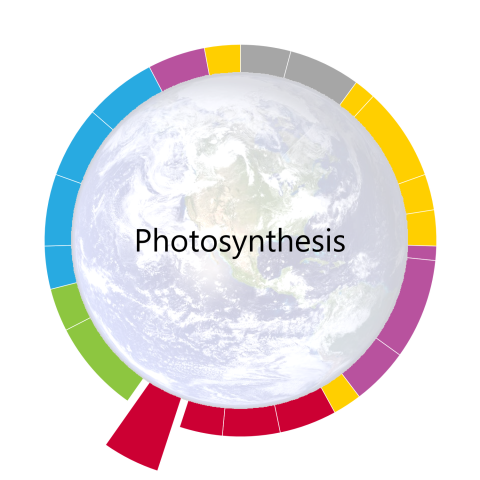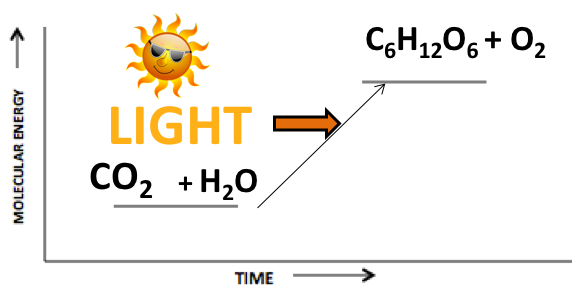
Phenomenon
Plants don’t eat yet they have matter to grow and somehow they have energy to live.
Question
How do plants get food? How do plants get the energy they need for life processes?
Model Ideas
As we move through the remainder of the Red Loop and develop ideas about matter and energy flow in organisms, we explicitly develop two models in parallel. In our work with cellular respiration, we primarily add ideas to a model for Energy from Food.
Matter from Food:
Model Ideas from Chemical Reactions
Matter is conserved, neither created nor destroyed. Matter is rearranged in chemical reactions.
Food has matter in the form of protein, carbs and fats- the same things we find our bodies are made of. We also take in matter as oxygen and water.
Some of this matter is used in our body, but we take in much more matter than we need to use to grow or maintain body structures.
Some of this matter (especially much of the water but also some indigestible material) basically passes through us.
Model Ideas from Cellular Respiration
Some of this matter is really taken in for energy. It is rearranged to obtain energy in a reaction called cellular respiration. The products are expelled from the body as carbon dioxide and water (CO2 + H2O).
Model Ideas from Biosynthesis
Some of the matter we take in is used to build proteins, fats and complex carbs that form cells of body structures.
Excess food not used for energy or building materials is converted to fat and stored.
New Model Ideas
- Plants take in low energy molecules (CO2 + H2O) and use energy from the sun to rearrange them into high energy molecules, glucose (C6H12O6 - food!) and O2. The reactions involved are collectively called photosynthesis.
- Over a 24 hour period, the rate of photosynthesis in a plant is greater than the rate of cellular respiration. As a result:
- Plants use more CO2 than they give off.
- Plants produce more O2 than they use.
- This means that a plant produces more glucose than it uses for energy.
- Glucose not used for energy is used to build biomass.
Energy from Food:
Model Ideas from Chemical Reactions
Energy is conserved, neither created nor destroyed. Energy is transformed in chemical reactions.
When the reactants have more potential energy than the products, energy is released in the reaction (“downhill” reaction).
[Electrolysis Classrooms Only: When the products have more potential energy than the reactants, energy must be added to the reaction (“uphill” reaction). ]
Food has energy in the form of calories.
Living things get energy by rearranging food and oxygen molecules.
Model Ideas from Cellular Respiration
Living things rearrange food (specifically glucose - C6H12O6) and O2 into CO2 and H2O.
(C6H12O6 + O2) have higher energy than (CO2 + H2O) so this rearrangement releases energy.
- The rearrangements occur in a series of steps rather than all at once.
- Collectively the reactions are called cellular respiration.
- Usable cellular energy is released in the form of ATP.
UNITY AND DIVERSITY: Other reactions (such as fermentation) can produce biologically usable energy, but they are usually less efficient. We see these reactions in some groups of organisms that have evolved under different environmental conditions and in our own bodies during times when oxygen is not readily available.
Model Ideas from Biosynthesis
Building large molecules (fat, protein, complex carbs) requires energy.
New Model Ideas
- Plants take in low energy molecules (CO2 + H2O) and use energy from the sun to rearrange them into high energy molecules, glucose (C6H12O6 - food!) and O2. The reactions involved are collectively called photosynthesis.

"Sometimes I use words I don't understand in order to make myself sound more photosynthesis."
Overview
Transition in: We now know how we get energy we need to survive and the matter we need to grow and maintain our bodies. But what about plants? Do plants have the same needs and processes? NOTE: This is where questions about plants that were “parked” in previous triangles can be very useful. There will be questions about whether or not plants need food, use O2, and/or produce CO2 - perfect motivation for the photosynthesis model.
We established in previous triangles that living things take in food and oxygen, rearrange them for matter and energy, and release carbon dioxide and water. But what about plants? Do plants need food? Plants don't eat, so how do they get food? To develop this model students explore how plants capture energy from the sun to build biomolecules (food!) in photosynthesis. Early on in the triangle design and conduct a lab to see how CO2 is involved in plants. Their results suggest CO2 is taken in when a plant is in the light and released in the dark. However, through discussion and activities, students ultimately reason that plants must be doing cell respiration all the time, but in light the effect is masked by photosynthesis. After mapping photosynthesis to our "uphill" model for chemical reactions, we reason through the reactants and products or determine their identity through videos, demos and/or student-run labs. (See PowerPoint for options and notes about increased class time needed for each.) Students can now use this model for Photosynthesis--along with the Chemical Reaction, Cellular Respiration, and Biosynthesis models--to explain where all the “stuff” comes from to when a seed grows into a tree (the "Seed to Tree" Challenge Question).
Total Time: 7-10 standard classroom days.
Transition out: We now understand how varied organisms obtain the matter and energy they need to survive and reproduce as individuals, but can we scale up our understanding and map the flow of matter and energy in ecosystems?
Advanced Planning
Materials:
(other than basic lab equipment - see lab teacher notes for quantities and details)
- bromthymol blue
- test tubes with screw tops or corks
- elodea (aka Anacharis): get at pet stores, or vendors such as Carolina Scientific
- straws
Other materials may be needed if running optional labs and/or demos (but since these labs are not provided directly in the curriculum, you will need to compile the list from the web resources we suggest or others of your choosing).
Download Resources
| Attachment | Size |
|---|---|
| All Resources for Photosynthesis | 23.08 MB |